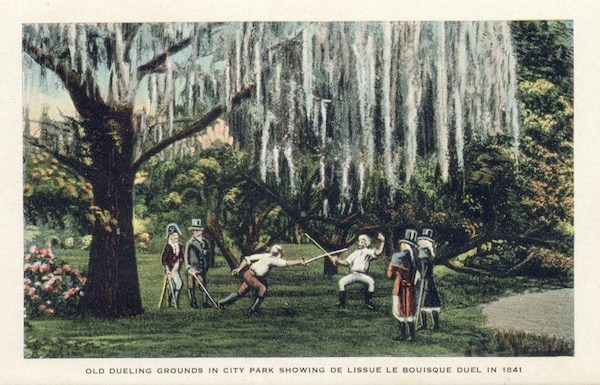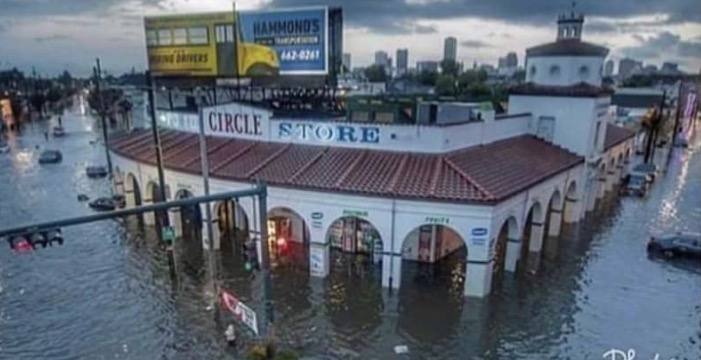Legal Humor, Uncategorized
Man Requests Trial by Combat in Custody Battle
Mr. David Ostrom of Paola, Kansas, frustrated by a custody battle with his ex-wife, has requested the Iowa District Court grant his motion for trial by combat, as the insults and troubles he alleges caused to him by his adversaries are so grave that satisfaction and justice can only be found “on the field of battle where (he) will rend their souls from their corporeal bodies.”
Of course, in this day and age, gentlemen such as Ostrom rarely have the appropriate soul-rending instruments at immediate hand, and therefore, Ostrom further requests of the Court a 12 week continuance in which he might procure or forge a suitable katana or wakizashi sword.
Ostrom argues that trial by combat has never been explicitly legally banned. He would also allow his ex-wife to select a champion to fight for her. Ostrom suggests that her attorney, Mr. Matthew Hudson, accept this honor, but Mr. Hudson appears to have declined, helpfully advising that “a duel could end in death.”
As sensational as this may seem to some, the trial of legal questions through combat has been requested of courts in the very recent past. In 2015, a New York defense attorney, feeling himself dishonored by the allegations of his adversary, moved for the opportunity to dispatch the offending party over the River Styx. It appears that this request wasn’t granted.
While this might seem strange in Iowa, Kansas, or New York, in New Orleans, satisfaction through combat is well established in tradition, and was practiced by the finest and most upstanding members of the community. In fact, according to preeminent historical scholar Alcée Fortier, more than ten individual duels were fought on a single Sunday in the city, and more duels were fought here in the 1830s than in any other city in the world!
Honor, especially the honor of the French Creoles, demanded that a gentleman be prepared to avenge insults on the field of battle. Schools were established throughout Old New Orleans where the young sons of prominent families would learn the art of swordsmanship.
Of course, not everyone in the city believed that men should be permitted to engage in consensual single combat. Dueling was technically illegal in New Orleans, but as it was a widely practiced cultural norm, not many were likely to report a duel to the authorities. Also, there was a very good chance that the authorities themselves might also have satisfied their honor on the field once or twice!
While the law itself didn’t concern New Orleanians, deference to the sanctity of law was something else entirely, and it became common to conduct one’s dueling in places that wouldn’t offend or inconvenience the general public, nor flaunt the dueler’s disregard of laws offensive to his own honor. Famously, a pair of grand live oak trees on the Allard Plantation became a popular site for settling an affaire d’honneur. Today, the Allard Plantation site comprises New Orleans City Park, and locals and visitors alike can visit the spot, where one of the trees still stands.
With the recent interest in judicially sanctioned dueling, nostalgic New Orleanians may cherish faint hopes that one day, a motion may be heard in Civil District Court to permit the remedying of insults in the most traditional of manners: on the field of honor.
Uncategorized
JUUL Targets Your Kids to Sell Vapes
NEW ORLEANS — The increasing popularity of vaping has led to decreases in sales of traditional cigarettes, but has also contributed to a disturbing spike in youth nicotine addiction. Nicotine use has serious detrimental health effects on children—and there’s concern that vaping companies such as JUUL might intentionally be targeting yours.
It’s important that all parents understand how nicotine impacts a teenager’s developing brain. Studies have shown that nicotine exposure even in small quantities “increases the risk of developing psychiatric disorders and cognitive impairment” because the chemical targets the delicate neurological structure in the brain. In adolescents, whose brains are still undergoing changes and are less developed in areas that control understanding risks versus rewards, nicotine’s disruption of the brain’s chemistry is enhanced. Immediately upon consuming nicotine, teenagers have disturbances in working memory as well as reduced prefrontal cortex activation, among other complicated effects. The prefrontal cortex of the brain is responsible for executive functions and attention performance, and is one of the last brain areas to mature. Continued consumption of nicotine in adolescence correlates with a progression of deleterious effects on the prefrontal cortex that suggest an impairment lasting later into life. Animal studies demonstrate that exposure during adolescence induces changes in gene expression within the brain. Your teenager is more susceptible to becoming addicted to nicotine because her brain’s ability to evaluate risk is not as developed as yours, while the “reward” of the nicotine high has a greater effect on her. And the nicotine itself, at very low levels, can cause irreparable harm to her mental health and cognitive ability. It’s a vicious cycle: children are more likely to use nicotine because of their immature minds, and nicotine harms their minds’ healthy maturation.
While our scientific explanation for teenage behavior progresses over time, we’ve known for years that children are more susceptible to addictions, have less willpower than adults, and are more easily swayed by short-term pleasures and rewards than adults. With that understanding, we might expect that purveyors of highly addictive chemicals would do anything possible to keep their products out of the hands of children. Unfortunately, evidence shows that the opposite is true.
Leaked internal documents from the major cigarette manufacturer Philip Morris demonstrates that they have intentionally targeted children since at least the 1970s. Below, some choice excerpts demonstrate Philip Morris’s strategy concerning children:
“Marlboro’s phenomenal growth rate in the past has been attributable in large part to our high market penetration among young smokers . . .15 to 19 years old . . . my own data, which includes younger teenagers, shows even higher Marlboro market penetration among 15-17year-olds.” [Philip Morris Document #1000024921/4927, May 21, 1975]
“Sales—Outstanding! Outstanding! Outstanding! . . .This account is located 2 blocks from Bellingham High School. Our pre-sell has sold through. The account had reordered and received more product. Sales field report.” [PM Doc. #87051949, March 8, 1988]
“[To support Marlboro’ s growth, Marlboro must] continue growth among new, young smokers…While Marlboro continues to attract increasing shares of young smokers, expected declines in the number of young people restrict future volume gains from this source.” [PM Doc. #2043440057/0112, 1985]
“Because of our high share of the market among the youngest smokers, Philip Morris will suffer more than the other companies from the decline in the number of teenage smokers.” [PM Doc. #1000390803/0855, March 31, 1981]
“Thus, the ability to attract new smokers and develop them into a young adult franchise is key to brand development.” [PM Doc. #2044895379/484, 1992]
“It is important to know as much as possible about teenage smoking patterns and attitudes. Today’s teenager is tomorrow’s potential regular customer, and the overwhelming majority of smokers first begin to smoke while in their teens . . . it is during the teenage years that the initial brand choice is made.” [Special Report, “Young Smokers: Prevalence, Trends, Implications, and Related Demographic Trends,” PM Document #1000390803/55, March 31, 1981]
“We wonder whether such children may not eventually become cigarette smokers in their teenage years as they discover the advantage of self-stimulation via nicotine. We have already collaborated with a local school system in identifying some such children in the third grade. . . Report on study of hyperactive children.” [PM Doc. #1003288122, June 10, 1974]
“[If Philip Morris took] a more progressive position on tobacco, it would enable the company to move onto a higher moral playing field, to neutralize the tobacco issue and to focus attention on other, more appealing products.” [PM Doc. #2023586677, December 3, 1992]
This “more progressive position” evolved into promoting electronic cigarettes and vaping as a “healthier alternative” to cigarettes. The “more appealing product” is one with no odor, that comes in a variety of child-friendly flavors including candy-sweet fruit flavors, and flavors replicating popular childhood cereals. The CDC now believes that a recent decline in youth cigarette smoking is directly related to a spike in children vaping. To the astonishment of parents everywhere, the Unites States Government has investigated and concluded that vape purveyor JUUL actually targeted children in camp and school under the guise of educating them about their health and the dangers of cigarettes
It may come as little shock, then, that the parent company of Philip Morris, author of last century’s campaign to turn children into customers, owns a 35% stake in JUUL.
Vape manufacturers who target children deserve to be held accountable for the severe, potentially permanent damage their product can cause. Class action lawsuits are forming to bring companies that target children to justice. If your child is using vapes like JUUL, contact The de Boisblanc Law Firm today.
How to Be a Good Plaintiff, Uncategorized
Mardi Gras Mayhem!
NEW ORLEANS, LA — Carnival season is in full swing, and the good times will be rolling all the way through Mardi Gras Day, which is March 5 this year. For the most part, locals and visitors alike will experience one of the best celebrations the nation has to offer, but with thick crowds, throws of all shapes and sizes tossed from moving floats, and an abundance of festive beverages flowing, there is a great potential for accidental injury. Yet even if you are injured by another person during Mardi Gras, you may not be able to recover any damages, depending on the circumstances of your injury. This is because of Louisiana Revised Statute 9:2796 , a uniquely Louisiana law which states in part that “no person shall have a cause of action against any krewe or organization, any group traditionally referred to as Courir de Mardi Gras, or any member thereof, which presents Mardi Gras parades” and advises that anyone attending Mardi Gras parades “assumes the risk of being struck by any missile whatsoever which has been traditionally thrown, tossed, or hurled by members of the krewe or organization in such parades.” Colorfully, these items include but are not limited to beads, cups, coconuts, and doubloons. Yet this law hasn’t gone without challenge.
One challenge to this law was brought by Mrs. Daisy Palmer and her husband against New Orleans’ century old Zulu Social Aid and Pleasure Club, which traditionally parades on Mardi Gras Day. Mrs. Palmer represented that while attending the parade, she had been struck in the head by one of Zulu’s signature coconut throws. The only exception the law has provided to the immunity coverage extended to krewes is if there is gross negligence involved. In this case, the Civil District Court for the Parish of Orleans did not feel that Palmer’s case was likely to prove an exception to the immunity law, and therefore ruled in favor of the Zulu Club. The Palmers appealed, and the Fourth Circuit Court of Appeals affirmed the lower court’s ruling.
In Duplantier v. Krewe of Pygmalion, et al, the court found that the immunity statute didn’t apply to all of the defendants, highlighting another important characteristic of the Mardi Gras Immunity Statute. Mr. and Mrs. Duplantier were injured when the float they were riding on collided with a tree limb. This was determined to possibly be due in part to the actions of the driver of the tractor towing the float. The court found that contracted employees of a krewe, who are compensated to provide services such as towing floats to the parading krewe, are not covered by the Mardi Gras Immunity Statute, and can therefore be found liable if their actions cause injuries to others.
Not only are Mardi Gras krewes extended special immunity in Louisiana, the state also provides that Mardi Gras Day can be considered a legal holiday. Louisiana Revised Statute 1:55 provides that “In the parishes of Orleans, St. Bernard, Jefferson, Plaquemines, St. Charles, St. James, St. John the Baptist, East Baton Rouge, Lafayette, St. Tammany, Iberia, St. Martin, Ascension, Washington, Calcasieu, Jefferson Davis, St. Landry, Evangeline, Cameron, Assumption, St. Mary, Acadia, Vermilion, Iberville, Pointe Coupee, West Baton Rouge, Lafourche, East Feliciana, and West Feliciana, and in all municipalities, Mardi Gras shall be a holiday when the governing authorities so declare by ordinance.”
So whether you’re planning to watch the parades from a friend’s balcony, in the grandstands, or on the street in your favorite spot, or if you’re visiting us from places where the day before Ash Wednesday is “just another day,” we hope you lassaiz le bon temps rouler and above all, stay aware and celebrate safely! Wishing you a fun-filled Mardi Gras from The de Boisblanc Law Firm!
Car Accidents, How to Be a Good Plaintiff, Truck Accidents, Uncategorized
Your Car’s Black Box is Monitoring You
NEW ORLEANS, LA — Chances are, the car you drive has a black box, also known as an Event Data Recorder, and it’s there to monitor almost all you do behind the wheel. If you’re in a crash, that EDR is able to supply such information as your speed, break use, engine throttle at the time of impact, and data from a dozen other mechanical categories, including whether or not you were wearing your seatbelt at the time of a collision. When a motorist is driving, the EDR continuously records data, but only in the event of a collision is that data stored, so that it can be retrieved by accident reconstruction experts, insurance companies, and even courts.
An Event Data Recorder has many useful functions. In some car accidents, it can be difficult to determine fault. When the EDRs of vehicles involved in a collision are analyzed, accident investigators or reconstruction experts can often determine which party was at fault, helping the victims of careless drivers find justice and compensation for their injuries. Event data recorders also help fight insurance fraud, which helps insurance companies save money and charge lower rates to customers. An EDR can help an insurance company determine the severity of a crash, so that it can analyze a claimant’s injuries and better ensure that the injuries make sense in the context of the crash. Some EDRs also record whether or not a seat was occupied at the time of collision. And finally, an EDR helps fight back against staged accidents.
The EDR can even help save lives. When accident investigators explore the data saved in the EDR of a vehicle involved in a catastrophic collision, they aren’t just able to analyze dangerous driving practices, they can determine if the vehicle encountered any mechanical failure, such as a failed airbag deployment or a faulty breaking system, which led to injury or loss of life. If the failure is the result of some deficiency in manufacturing, an automaker can enact a recall to solve the problem, perhaps saving many lives.
However, in spite of all of the benefits of the EDR, some believe that Event Data Recorders invade our privacy. In today’s world, it’s concerning that a computerized device in our vehicles might be used to determine where we go and when, potentially revealing other personal details about our lives. Americans are concerned over who can have access to the data stored in their EDR. Might an employer, or some other third party, be able to access that information? The Driver Privacy Act of 2015 aims to address these concerns. Unless authorized by a court, necessary to provide post accident medical treatment, used to carry out investigations that are authorized by Federal Law, or anonymously used for purposes of traffic safety research, the owner of a vehicle owns his EDR data, and a third party must obtain his consent before accessing his driving data.
Technology such as the Event Data Recorder will continue to evolve and enhance, as will questions and concerns about the potential uses of such data. It’s important for motorists today to realize that their vehicle is most likely equipped with an EDR, and that the EDR will help them understand just how a crash happened, should they be involved in a motor vehicle collision. If you’re involved in any motor vehicle accident, it’s important to consult an experienced attorney like the attorneys at the de Boisblanc Law Firm, who can help you protect your rights, and seek compensation if another party’s negligence has injured you.
Uncategorized
Traumatic Brain Injury Warnings
NEW ORLEANS, LA — Traumatic Brain Injury (TBI) is a common, costly, and often fatal result of a motor vehicle crash. It can be caused when the head strikes or is struck by an object, or is subjected to the violent jarring motion known as “whiplash” that is often caused in car or truck crashes. The American Academy of Neurosurgeons estimates that nearly 1.7 million brain injuries occur each year, and of these, up to 70% may be caused by motor vehicle collisions. According to the CDC, motor vehicle crashes were the leading cause of TBI death for persons 5-24 years of age.
However, even if the victim survives the brain injury, his or her life will likely be forever changed. In the most severe cases, the victim will require medical life-support or around-the-clock nursing care. Even in minor cases, symptoms such as “confusion, lightheadedness, dizziness, blurred vision, ringing in the ears, fatigue or lethargy, a change in sleep patterns, behavioral or mood changes, and trouble with memory, concentration, attention, or thinking” may interfere with or take away the victim’s ability to earn income. Medical science cannot yet reverse injury done to the brain, although rest, and hyperbaric treatments, may help to improve symptoms. This means that the victim may lose their lifetime income following a TBI, just when their medical bills are rapidly piling up.
The cost of caring for someone who has suffered a Traumatic Brain Injury will be directly related to the severity of their injury. The CDC estimated that the annual cost of TBI in the United states is around $76 billion dollars. An individual with even minor brain injuries can expect to spend tens of thousands of dollars on neurological consultations and rehabilitation. The annual estimated cost in 1991 dollars for a severe TBI was approximately $222,600. When these costs are added to the estimated lifetime loss of income, it becomes clear that the all-to-common TBI is as devastating financially as it is medically.
If you or a loved one has been involved in a car collision, emergency medical care may not initially diagnose a Traumatic Brain Injury. While medical science advances and most emergency physicians will examine the motor vehicle collision victim for signs of concussion and brain injury, mild injury has been referred to as “the silent epidemic” due to the alarming potential for missed diagnosis. It is essential that you report any symptoms, such as dizziness, headaches, or disorientation to your doctor both at the ER and during your follow-up care. And due to the high costs of medical care, and potential for loss of income, it is equally important that all car crash patients or those who care for them seek immediate legal advice to determine if they are able to recover for the damages, past and future, that are associated with car-crash related TBI.
The de Boisblanc Law Firm is experienced in handling victims of TBI, whether caused by a car crash or another form of accident. If you or a loved one have been in an accident involving a head injury, we can help you pursue financial recovery from the person who caused your injury, which will help you protect yourself or your loved one during this exceptionally challenging and uncertain time.
Uncategorized
Who is Liable for New Orleans Flooding?
NEW ORLEANS, LA — Is the City of New Orleans liable for August 5, 2017 Orleans Parish flooding?
Before the waters receded, New Orleans residents witnessed an astonishing display of conflicting messages and finger pointing. Initially, residents were told by New Orleans Sewerage and Water Board Director Cedric Grant that the flooding was caused by climate change, and should be considered a new normal. This prompted considerable backlash, and as Jefferson Parish didn’t share in the diluvian nightmare, Orleans Parish residents wondered aloud what properties the Orleans-Jefferson parish border had to stop climate change. At the same time, citizens shared their own live videos and photographs of idle pumping stations, and slowly the city admitted that several pumps hadn’t been in operation, due to “routine maintenance”. Over the course of the next few days, New Orleans witnessed the resignation of Director Grant, who blamed his staff for giving him “bad information.” Heads rolled at the utility, a fire occurred in one of the turbines driving the pumps, and by Sunday, August 9, Mayor Mitch Landrieu told New Orleans that 17 of the city’s 121 pumps were in need of “emergency maintenance”, that “outstanding maintenance issues (could be) hindering even some of the 103 pumps considered to be in working order,” and only two of the city’s six turbines were operational. Echoing Cedric Grant, Mayor Landrieu, the President of the Utility’s Board of Directors, stated that he had not been aware of the issues plaguing the critical flood-mitigation infrastructure.
Not knowing a problem exists doesn’t always prevent a party from being held liable. When considering torts– acts or omissions that cause injury or harm—a party may be held liable if he knew or should have known that his action (or lack of) could cause injury or harm. Negligent torts occur when a party’s actions are unreasonably unsafe, and the party defendant owed the plaintiff a reasonable standard of care. Going further, gross negligence is “a conscious and voluntary disregard of the need to use reasonable care, which is likely to cause foreseeable grave injury or harm to persons, property, or both.”
In considering whether or not Mayor Landrieu and the Sewerage and Water Board are liable for flood related damages, we must determine if the Mayor and the Utility knew or should have known about the systemic failure of their pump systems. It may have been that the failure occurred immediately prior to the rain event which led to the flooding, and in that case, the Mayor and the Utility might have been able to claim all innocence of the failure. While operational data can be subpoenaed during litigation, we may look to the Utility’s own 2011-2020 Strategic Plan, obtainable at https://www.swbno.org/docs.asp. In this plan, the Sewerage and Water Board states on page four under “Weaknesses” that they have “deferred maintenance of infrastructure.” This suggests a potential pattern of the Sewerage and Water Board, under the direction of Mayor Landrieu, of postponing or even neglecting maintenance. The flooding event occurring six years after this self-identified operational weakness reveals that there is systemic failure in the infrastructure system, which suggests a gradual decline of capabilities only possible if the admitted “deferred maintenance” had not be corrected, after being recognized. Whether or not the Mayor states that he was not aware of any of these issues, as President of the Board of Directors, it is his responsibility to read strategic plans created for the improvement and success of the Utility. By this alone, we see that the Sewerage and Water Board knew that the deferred maintenance of their infrastructure was a weakness, and that Mayor Landrieu should have known that the maintenance of infrastructure was a challenge for the Utility. While only operational details will fully clarify the issue, it stands to reason that the systemic infrastructure failure that caused the flood of August 2017 would only be possible had that infrastructure lacked in critical maintenance. Therefore, the Mayor and the Sewerage and Water Board may be exposed to the allegation that they committed a tort against the citizens of New Orleans.
In determining whether or not the Mayor and Utility were grossly negligent, it is clear that failing to maintain flood-mitigation infrastructure could foreseeably cause harm. New Orleans, a city below sea-level and sandwiched between the Mississippi River and Lake Pontchartrain, is not only susceptible to flooding, it is prone to intense hurricanes. No resident will forget Hurricane Katrina, which cost an upwards of 1,500 lives mainly due to flooding caused when the levee system failed to protect the city. However, it isn’t enough to be able to foresee harm; the Mayor and the Utility must have engaged in a conscious and voluntary disregard of the need to use reasonable care. To determine that possibility, we examine the importance placed upon the Sewerage and Water Board’s pumping infrastructure by the Department of Homeland Security, the Federal Emergency Management Agency, and the Utility itself. In the aftermath of the devastation, Congress authorized more than 14 billion dollars in funding to repair and upgrade the flood-mitigation infrastructure, and put in place myriad programs and partnerships between local, state, and federal government agencies to mitigate risk. The Sewerage and Water Board, in charge of the city’s flood-water drainage system, was identified as a partner in Department of Homeland Security flood resiliency training exercises. In 2007, FEMA identified the Sewerage and Water Board of New Orleans as a partner in complying with The Disaster Mitigation Act of 2000, and earmarked $47,000 for the Utility to develop a compliant hazard mitigation plan. During the creation of this plan, the Utility identified its pumping stations as “critical” in mitigating hazards such as Katrina*. Only two years after the Utility designated the pumping infrastructure as “critical”, the Utility cites its own “deferred maintenance” as an operational weakness. The Mayor and the Utility were well aware of the essential, life-and-property protecting nature of the pumps; funds and direction from federal government partners had been made available to the City; and nonetheless, the Utility engaged in a pattern of deferred maintenance on infrastructure. On August 5, 2017, flood waters revealed that almost every single part of the pump system, from the pumps themselves to the turbines powering them, was significantly compromised. While discovery is needed to help us determine if there was a deficit of time or resources, whereby a more essential piece of flood-mitigation infrastructure, if any exists, took necessary resources away from the pump system, it appears on this examination that an allegation of gross negligence may be made against Mayor Landrieu, and the Sewerage and Water Board of New Orleans.
*Found at C:\Users\112589\AppData\Local\Temp\Hazard_Mitigation_Public_Meeting-1.pdf







